
ISSN: 2321-9653; IC Value: 45.98; SJ Impact Factor: 7.538 Volume 10 Issue XII Dec 2022- Available at www.ijraset.com


ISSN: 2321-9653; IC Value: 45.98; SJ Impact Factor: 7.538 Volume 10 Issue XII Dec 2022- Available at www.ijraset.com
Yaqoub1 , Dr Gurinder Kaur Sodhi2
1M. Tech Scholar, 2Assitant professor and HOD, Department of Electronics and Communication Engineering, Desh Bhagat University, Mandi Gobindgarh, Punjab, India

Abstract: A diabetes condition called diabetic retinopathy damages the vasculature channels, affecting the eyes. It may be asymptomatic at first or it may cause fluctuating vision problems. As the illness progresses, both eyes are affected, culminating in a partial or entire loss of eyesight. Usually, it happens when blood sugars are out of control. An individual suffering from diabetes mellitus is therefore constantly at danger of contracting the illness. Early detection might prevent the possibility of complete and lasting disability can be averted. As a result, a reliable screening procedure is necessary. The current research investigates Specifically, a Multilayer Perceptron Pertained Network from machine learning (ML) (DenseNet-169), that can be utilized to diagnose diabetic retinopathy early. It categorizes fundus photographs into four groups: Angiogenesis DR, weak, mild, with intense DR. Both the 2015 Diabetic Retinopathy Prediction and the 2019 Aptos Impairment Recognition have been obtained from Kaggle and applied to this study. The steps of the suggested technique include record keeping, preparation, enhance, and simulation. 90 percent precision was attained by our suggested model. Additionally, the statistical method was used, and its efficacy was 78%. This research's main purpose is to develop a reliable approach for identifying different DR.
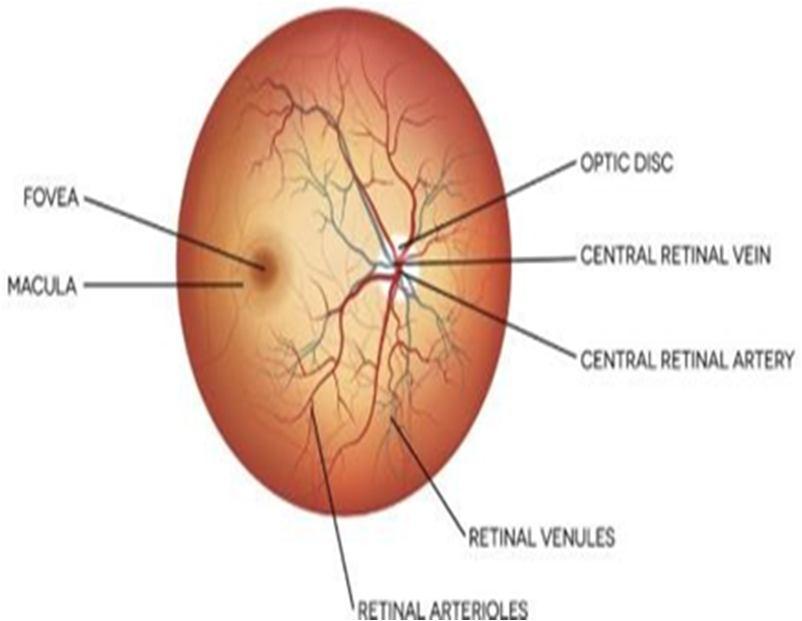

Keywords: Diabetic Retinopathy, Retinal Images, Convolution Neural Network
One of the world's most prevalent diseases is mellitus, and its incidence is increasing globally. It is mostly associated to excessive blood sugar levels and insulin production in the body [1] leading to abnormal cellular metabolism and side effects as diabetes mellitus (vision loss), atherosclerosis, kidney damage, and cognitive disorders, among others. A terrible eye condition called diabetic neuropathy causes irreversible vision loss for life. People who have had diabetes before are more likely to develop the disease; whether type 1 or type 2 diabetes, the chance of acquiring the disease increases with age [2].Diabetic retinopathy is a dangerous eye disorder, according to the WHO, that requires rapid international attention. According to a study, India has 60 million mellitus are treated with about 12,000 practitioners eyesight impairments. The fact that most people are unaware they have this ailment, is one of the main reasons for the huge number of sufferers. When it comes to this illness, they also show a lack of sensitivity and prudence. DR affects around 18 percent of diabetics, and the chance of developing it is 25 times higher in diabetics than in healthy people [3] because this disorder is asymptomatic or has very little symptoms, early detection is difficult, resulting in eyesight damage by keeping a person in the night. As a result, early detection of DR is crucial for preventing the disorder's complexity. The employment of highly effective technologies and techniques by professionals and specialists who assist advancements in improving the prognosis of this illness is required for the identification due to sickness.
ISSN: 2321-9653; IC Value: 45.98; SJ Impact Factor: 7.538

Volume 10 Issue XII Dec 2022- Available at www.ijraset.com
Figures 1 and 2 display pictures of retinas with and without vision loss [4] An infallible automatic detection method is essential since it is vital to categorize and avoid the severity degree of DR. The majority of DR research formerly relied on edge detection applying methods from computer science; however the difficulties of manual feature extraction led researchers to shift to deep learning. Machine learning based, machine learning, image recognition, and information gathering are just a few of the computerassisted technologies that have emerged as a result of more medical research. Contrarily, reinforcement learning has become more popular in a variety of industries, including attitude interpretation, writing identification, stock market forecasting, and medical picture interpretation., to name a few. CNN in deep learning produces positive results when it comes to photo classification. Figure 3[5] shows CNN's structure and the numerous layers that make it up.
Deep learning methodology, namely the CNN variation DenseNet, is used in the latest study., to categorize fundus (eye) pictures based on severity degree, which obtains segmentation data rather than laborious. The "Diabetic Retinopathy Detection" 2015 data set from Kaggle was coupled with the "Aptos 2019 Blindness Detection “data collected for this inquiry from Kaggle.
Our purpose is to diagnose diabetic retinopathy and establish if it is a PDR or an NPDR. The following are the particular goals of this research:
1) Identify Diabetic Retinopathy by processing colour fundus retinal images.
2) Extract crucial attributes from the pre-processed photographs.
3) Determine whether you suffer from Diabetic Retinopathy.
4) Determine if you have proliferative or non-proliferative diabetic retinopathy
Gardner et al. (1996) [42] was one of the inaugural researchers to suggest human brains for DR detecting, employing them to identify specific areas of the original picture. The properties of the regions were classified by an ophthalmic, and the results were entered into the SVM. Ege et al. [43] recommended using Bayesian detectors and k-nearest partners to identify DR in the year 2000. SVM was used by To determine the extent of regions with various DR characteristics including haemorrhages, sub, oedema, and blood vessels, researchers used Acharya et al. (2008) [44] and Adarsh et al. (2013) [45].
Three separate models including a Sparse representation prototype (GMM), KNN, and the support vector machine was utilized by Roychowdhury et al. (2014) [46] (SVM). These methods, on the other hand, have the disadvantage of only using a small number of properties. The attention has shifted to Convolutional Neural Networks when The Large Scale Visual Recognition Challenge was won in 2012 [47] by Alex Krizhevsky et al. (CNNS).


The most prevalent micro vascular consequence of diabetes is diabetic retinopathy (DR) [14].
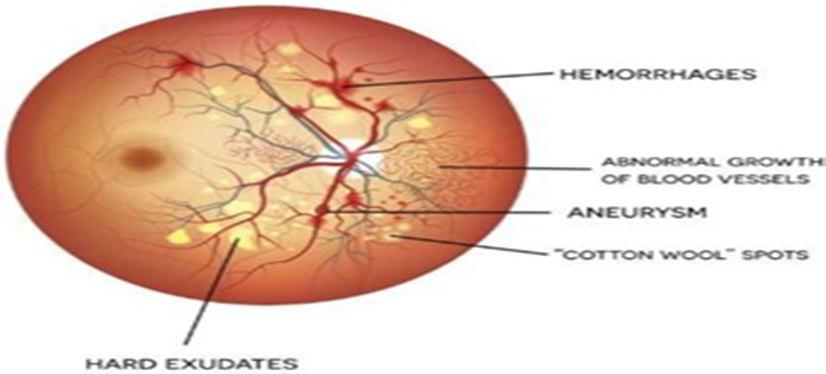
ISSN: 2321-9653; IC Value: 45.98; SJ Impact Factor: 7.538 Volume 10 Issue XII Dec 2022- Available at www.ijraset.com

Figure 4 Model of seeing using the ophthalmoscope.

It is a frequent chronic macular diabetic consequence and the main reason why people of operating go blind in the United States, industrialized nations [6]. Long-term hyperglycaemia in small retinal arteries and capillaries alters the structure and function of retinal cells [15].
1) Epidemiology: Diabetic individuals are becoming more common [6]. More than 858 thousand persons in the Czech Republic had diabetes mellitus in 2016, with 95 100 people developing diabetic retinopathy and 2 267 people being blind as a result of the condition [16]. It affects around 4.2 million people all over the world. In the United States, the number of persons living by 2050, it is expected that 16.0 million people would have DR, 3.4 million of whom will have image vision loss. With $492 million USD in direct medical expenses and missed time and pay from getting help, DR is a serious public health problem [8].
2) Symptoms: Patients with DR have a wide range of symptoms. This is because the patient may not notice any subjective symptoms until the macula has been damaged. The most common symptoms [16] are as follows: Blurry or issues with stability and blurred eyesight that make viewing and reading TV challenging enhanced light sensitivity Having problems at night?
3) Medical indicators: Health indications comprise:
a) Microaneurysms: Early signs of DR include small, circular, red tumours in the retina that are not visually apparent, bothersome and normally go away in 3 to 4 months.
b) Retinal Haemorrhages: Haemorrhages can be of various sizes and forms in different layers of the retina.
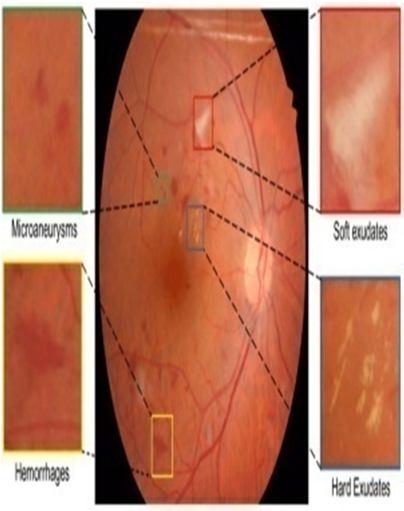
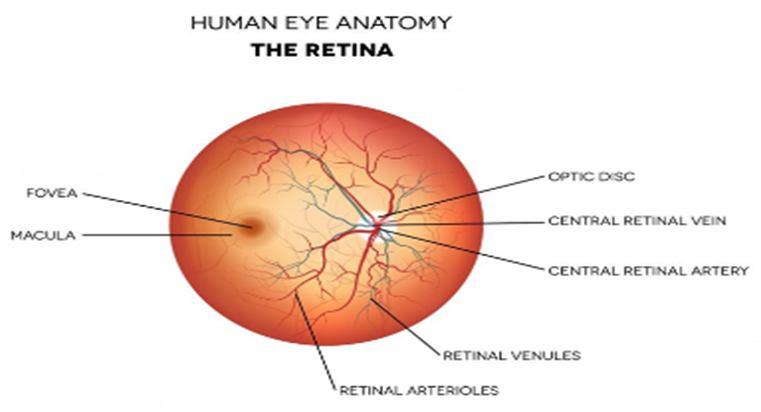
c) Hard (Lipid) Exudates: Depositions of lipids and proteins appear as yellow irregularly shaped lesions with sharp edges. This is an indication the development of DPN, which often occurs and around middle when paired with retinal thickness.
d) Cotton-Wool Spots (Soft Exudates): Without white patches fading margins, commonly surrounding the optic disc, indicate a nerve fibre layer infarct, an indication of retinal ischemia [8].
e) Intraretinal Micro Vascular Abnormalities (Irma): The formation of new blood vessels or the remodelling of existing ones can both produce abnormal branching or dilatation of existing blood vessels [17].
f) Macular Edema: When the blood-retinal barrier is disrupted, plasma leaks into the retinal tissue, causing edema. Any stage of DR is susceptible to it and can lead to retinal wall detachment [8].
g) Venous Bleeding: Veins that are dilated, irregular, and convoluted are an indirect indicator of retinal ischemia. Neovascularisation is the term for the unnatural development of new arteries. As they expand into the posterior chamber, these lines can block vision and perhaps causing bleeding. Full retinal detachment can result from irreversible changes in the retinal structure [6]. Fibrosis and changes in retinal strain: A complete lesion can result from extreme alterations in the retinal structure.

ISSN: 2321-9653; IC Value: 45.98; SJ Impact Factor: 7.538 Volume 10 Issue XII Dec 2022- Available at www.ijraset.com
DR affects between 80 and 100 percent of people. When a patient is diagnosed with Type 1 DM, it is rarely recognized; nevertheless, 99 percent of persons have the DR diagnosis after 20 years. Capillary closure in people with diabetic results in retinal inflammation and dehydration which are followed by endothelium. Due to fibro and age - related macular degeneration, these nascent vessels are delicate, and they can easily burst and bleed (vitreous haemorrhage), resulting in decreased vision and eventually blindness.
DR may be present when Type 2 diabetes is diagnosed. Among 58 and 85% of people develop DR after ten years. (3), (4) Type 2diabetes is more typically seen in the retinal background than ischemia, resulting in micro aneurysms and macular edema, the most frequent reason for visual deterioration in Type 2 diabetes (see Figure 2.4) [15].
Figure
1) Hypertensive retinopathy: DR is frequently mistaken as another condition retina brought on by hf (HR). Cotton-wool areas, optic haemorrhages, and vascular anomalies set HR and DR apart from one other. Arteries snatching, a disease during which tiny visual veins and arteries start to crossover and emerge, contrasts HR from DR [6].
2) Clustering of DR: We classified DR into two phases, anti and disseminate, depending on the specific the world categorization, with each degree holding its own subtypes based on severity and seriousness Ocular neovascularisation is a significant difference between NPDR and proliferative DR (PDR). [8] Diabetic macular edema can strike at any time and in any form.
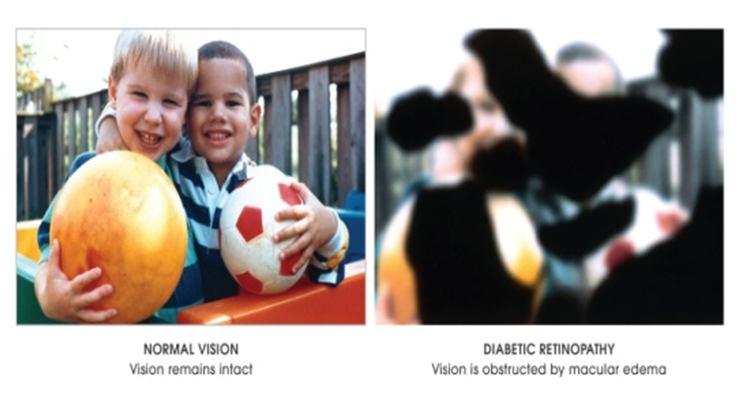
1) Mild NPDR: soft lesion, flannel patches, and venous changes in the midline with moderate NPDR + micro aneurysms, retinal haemorrhage, venous beading
2) Severe NPDR: This further haemorrhage with haemorrhaging there in lower photoreceptors is referred to as major Statement of profit and loss - + IRMA. Peripheral eye, proliferate/proliferative (PDR):
3) Mild PDR: high-risk PDR neovascularisation of the retina and optic disc - the iris neovascularisation
4) Advanced PDR: neo vascular glaucoma, retinal detachment, effect was observed bleeding [6].
The main purpose of this research is to develop a method for detecting vision loss that is both reliable and noise-tolerant. This study uses deep learning technology to identify diabetic retinopathy at various levels of severity (Proliferative, Mild, Robust, Severe, and No DR). Before pictures were uploaded to the network, many procedures were finished. In this work, we developed two models our suggested model and a regression method, then tested their respective degree of precision. Even though the method we described outperformed the predictive model. Figure 4 shows the suggested approach.
Data Collection
Data Preprocessing Data Augmentation
Modelling Results
Figure 7 Proposed Technique

ISSN: 2321-9653; IC Value: 45.98; SJ Impact Factor: 7.538 Volume 10 Issue XII Dec 2022- Available at www.ijraset.com

The Diabetic Retinopathy Monitoring 2015[21] and APTOS 2019 Retinal Detection [22] datasets were utilized in this investigation. There are numbers of optic photos from various environments in both databases. Images including both eyes, left and right, are sent to each volunteer. As a result of the photographs coming from many sites, involving various cameras, mannequins,, and so on. It has a significant amount of noise that must be removed, necessitating a number of pre processing methods. Each candid photos associated dry macular was given a rating between 0 and 4, as follows:
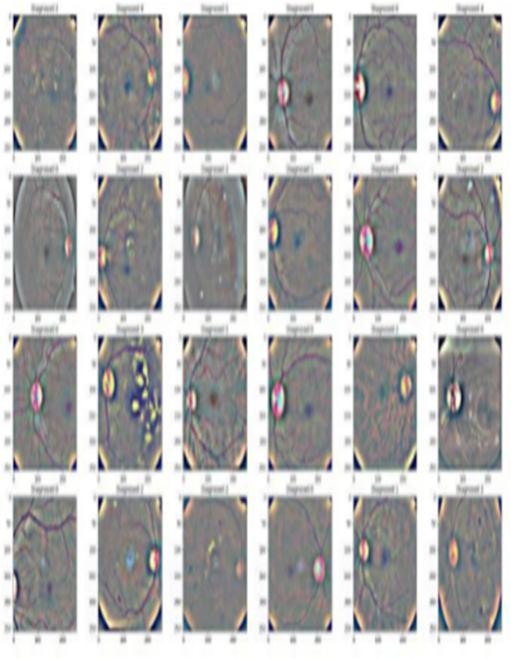
1) 0 - No DR
2) 1 - Mild
3) 2 – Moderate

4) 3 - Severe
5) 4 - Proliferative DR
Figure 5 depicts retinal pictures with severity levels ranging from 0 to 1.
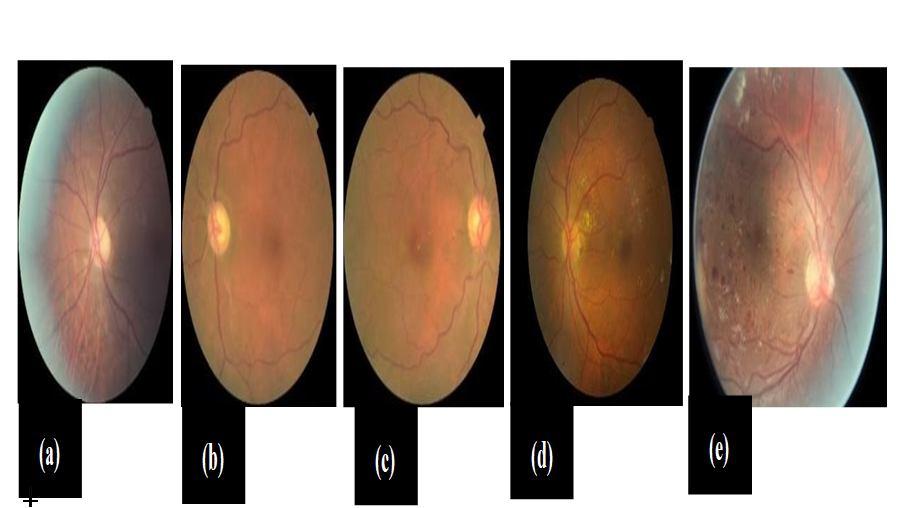
Figure 8 premised on the dataset's sample points for symptoms: Level '0' is represented by (a), Level '1' by (b), Level '2' by (c), Level '3' by (d), and Level '4' by (e).
We need to pre-process the pictures in the dataset to get them into the usual format since they contain a lot of pollution, such as out of focus images, images with a lot of exposure, images with extra illumination, images with a dark backdrop, and so on. The following tasks are accomplished in the preparatory step:
1) Removing The Black Border: The black lines surrounding the images has also been cut even though it does not offer any details to the image sequence and is thus unneeded.
2) Remove The Black Corner: Because the fundus picture is circular, there are still some dark corners after eliminating the black border. The image's black edges are eliminated in this stage.
3) Resizing Image: The photos have been reduced in size to 256*256 pixels (width*height).
4) Utilizing the Gaussian Blur: The photos are given a Gaussian blur by setting the hardware abstraction layer to 256/6 bytes. Gauss noise can be reduced with the use of this method.
Figure 9demonstrates the photos that were produced after pre-treatment was done..

ISSN: 2321-9653; IC Value: 45.98; SJ Impact Factor: 7.538 Volume 10 Issue XII Dec 2022- Available at www.ijraset.com
According to our collection of the information, the distribution of the disease severity picture groupings is noticeably unequal (see figure 7), Implying that data augmentation is likely.
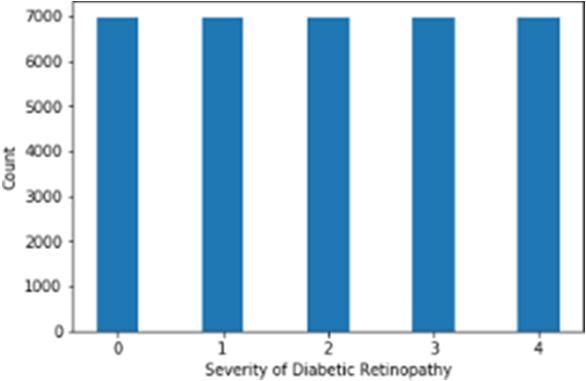
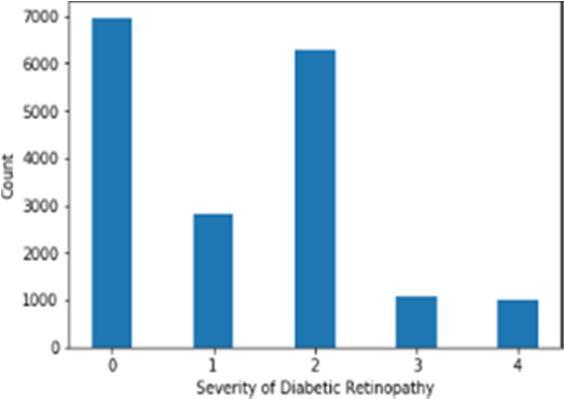
We used a DenseNet-169(Densely connected CNN model) and a five-node output for each class to generate this layer. Global Average Pooling 2D works similarly to 2D pooling, with the exception that it accepts the whole incoming pool size determined on Bitcoin network. The imbalanced datasets problem is tackled with an auto encoder. The settings for coaching this prototype are optimized using the Adam optimization techniques. Generally be defined, dropouts, dense, expander, for education, we combined a simple model with a heavily linked CNN model called DenseNet-169. With no top or final layer, DenseNet-169 transfers scores up to the brain. There is just no final layer is when circuit is originally modelled. Worldwide Average pooling 2D with a 0.5 DNN was employed and certain other layers are added and tuned using a stepwise analysis methodology.
1) Convolution layer: To go through the fundus pictures and generate a dot product, it uses numerous kernels or filters. This layer's kernels and filters each draw different picture features.
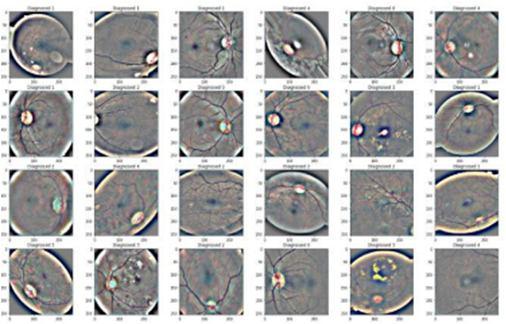
2) Pooling layer: By lowering the spatial dimension, it gives an abstract convoluted installation. It is analogous to the convolutions, but employs either the maximum or minimum, dependant on the kind of dipping from the density intake.
3) Dropout layer: To govern neural networks and avoid over-fitting, the dropout method has been applied.
4) Level the layers: The data after a one series is moved to the previous layers by straightening. [23].
Figure 10 [24] shows the deep DenseNet-169 framework, which consists of three Dense blocks, system requires tiers, besides a dumping and combining network.

Figure 13 3 incredibly dense modules in the DenseNet-169 layout

ISSN: 2321-9653; IC Value: 45.98; SJ Impact Factor: 7.538 Volume 10 Issue XII Dec 2022- Available at www.ijraset.com


The implementation was done in Python, utilizing a variety of image processing tools and familiarization with the DenseNet-169 technology for building convolutional neural networks. OpenCV [25] would have been the library used for self - enhancement (including rotation and scaling) and editing. NumPy was used to carry out the algebraic calculations necessary for the performance [26]. Scikit-learn [28] and TensorFlow [27] were also employed to maintain and create deep learning models quickly. To make processing easier and faster, the model's implementation takes advantage of a GPU-enabled device.
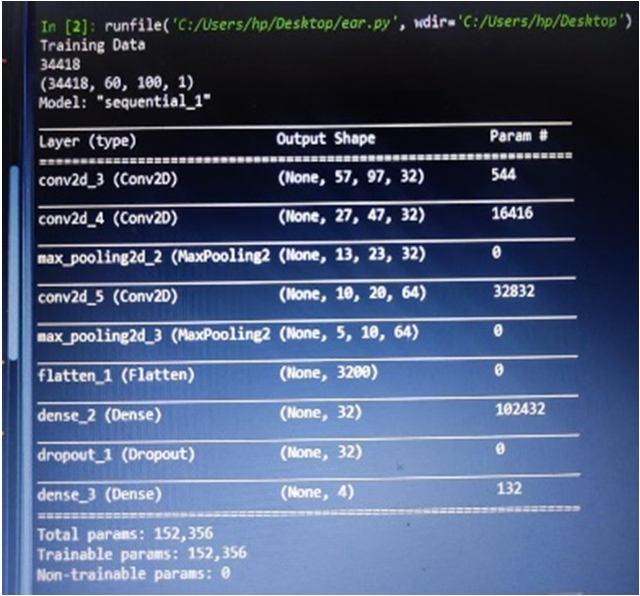

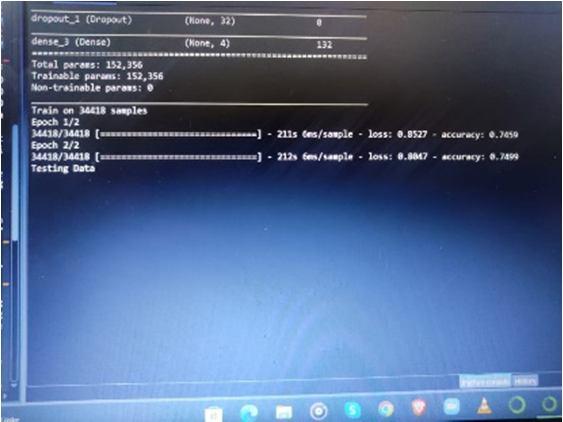
We developed our simulation plan with DenseNet-169 and to use a mix of kaggle examples form Diabetic Retinopathy Monitoring 2015[21] and APTOS 2019 eyesight assessment [22]. Pre-processing was necessary since the pictures produced by the dataset contained a lot of noise. The photos were pre-processed by In order to get closer to x ray picture alone, a black accent and ends were removed and shrunk to a size of 256*256 in both horizontal and vertical directions. Lastly, to eliminate Gaussian noise, the pictures were blurred with a Gaussian blur.
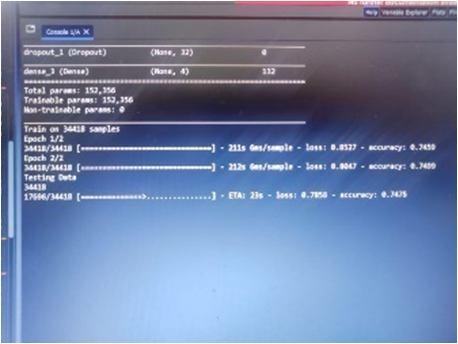
ISSN: 2321-9653; IC Value: 45.98; SJ Impact Factor: 7.538 Volume 10 Issue XII Dec 2022- Available at www.ijraset.com


We noticed that the data was considerably unequal across the severity classes after pre-processing, with the majority of the data falling into class "0," meaning no DR. To solve this problem, we employed ensemble learning, which provided us with 7000 images from each quality class and adjusted the data. Imagery were pre-processed and enhanced before data was sent to the DenseNet-169 machine for retraining. We were successful in obtaining model performance of0.953 and a validation accuracy of 0.9034 after evaluating our model.
In this research, a number of methods for automatically employing a DenseNet-169, we attempted to present special deep learning algorithms for vision early treatment after reviewing existing research on the diagnosis of this disease. For this investigation, the kaggle datasets "Cirrhosis Detect 2015" and "APTOS 2019 blindness detecting" were joined. The suggested method was tested against different ML categories, such as SVM, DT, and Decision trees. The presented method splits the graphics into many groups which is the most accurate of them all. The multiple regressions was outperformed by our suggested model achieving a 90% accuracy rate, whereas the regression model only obtained a 78% accuracy rate.

[1] International Diabetes Federation- Facts & Figures. Available -online: https://www.idf.org/aboutdiabetes/what-is-diabetes/ facts-figures.html (accessed on 13 November 2020).
[2] Diabetes. Available-online: https://www.who.int/news-room/fact-sheets/detail/diabetes (accessed on 13 November 2020).
[3] Diabetes Treatment: Using Insulin to Manage Blood Sugar Mayo Clinic. Available-online: https://www.mayoclinic.org/ diseases-conditions/diabetes/indepth/diabetes-treatment/art-20044084 (accessed on 13 November 2020).
[4] Diabetic Retinopathy Data and Statistics | National Eye Institute Available-online: https://www.nei.nih.gov/learn-about-eye- health/resources-for-healtheducators/eye-health-data-and-statistics/diabetic-retinopathy-data-and-statistics (accessed on 13 November 2020).
[5] Diabetes and You: Healthy Eyes Matter! 2014. Available-online: https://www.cdc.gov/diabetes/ndep/pdfs/149-healthy-eyes- matter.pdf (accessed on 13 November 2020).
[6] National Diabetes Statistics Report, 2020 | CDC. Available-online: https://www.cdc.gov/diabetes/data/statistics-report/index. Html (accessed on 13 November 2020).
[7] Key Facts about Diabetic Retinopathy [Infographic] | WelchAllyn. Available-online: https://www.welchallyn.com/en/ education-and-research/researcharticles/key-facts-about-diabetic-retinopathy-infographic.html (accessed on 5 March 2021).
[8] Islam, M.M.; Yang, H.-C.; Poly, T.N.; Jian, W.-S.; Li, Y.-C. Deep Learning Algorithms for Detection of Diabetic Retinopathy in Retinal Fundus Photographs: A Systematic Review and Meta-Analysis. Comput. Methods Programs Biomed. 2020, 191, 105320. [CrossRef]
[9] Hemanth, D.J.; Deperlioglu, O.; Kose, U. An enhanced diabetic retinopathy detection and classification approach using deep convolutional neural network. Neural Comput. Appl. 2020, 32, 707–721. [CrossRef]
[10] Shankar, K.; Sait, A.R.W.; Gupta, D.; Lakshmanaprabu, S.K.; Khanna, A.; Pandey, H.M. Automated detection and classification of fundus diabetic retinopathy images using synergic deep learning model. Pattern Recognit. Lett. 2020, 133, 210–216. [CrossRef]
[11] Gayathri, S.; Gopi, V.P.; Palanisamy, P. A lightweight CNN for Diabetic Retinopathy classification from fundus images. Biomed. Signal Process. Control 2020, 62, 102115. [CrossRef]
[12] Liu, H.; Yue, K.; Cheng, S.; Pan, C.; Sun, J.; Li, W. Hybrid model structure for diabetic retinopathy classification. J. Healthc. Eng.2020, 2020, 8840174. [CrossRef]
[13] Shankar, K.; Zhang, Y.; Liu, Y.; Wu, L.; Chen, C.H. Hyperparameter Tuning Deep Learning for Diabetic Retinopathy Fundus Image Classification. IEEE Access 2020, 8, 118164–118173. [CrossRef]
[14] Li, X.; Hu, X.; Yu, L.; Zhu, L.; Fu, C.W.; Heng, P.A. CANet: Cross-Disease Attention Network for Joint Diabetic Retinopathy and Diabetic Macular Edema Grading. IEEE Trans. Med. Imaging 2020, 39, 1483–1493. [CrossRef]
[15] Li, Y.H.; Yeh, N.N.; Chen, S.J.; Chung, Y.C. Computer-Assisted Diagnosis for Diabetic Retinopathy Based on Fundus Images Using Deep Convolutional Neural Network. Mob. Inf. Syst. 2019, 2019, 6142839. [CrossRef]
